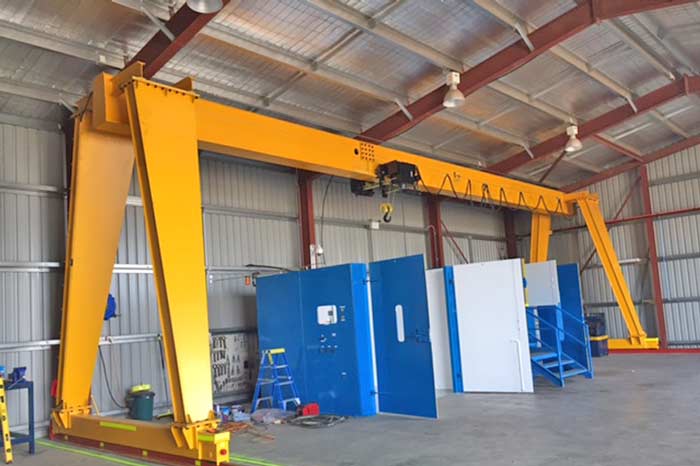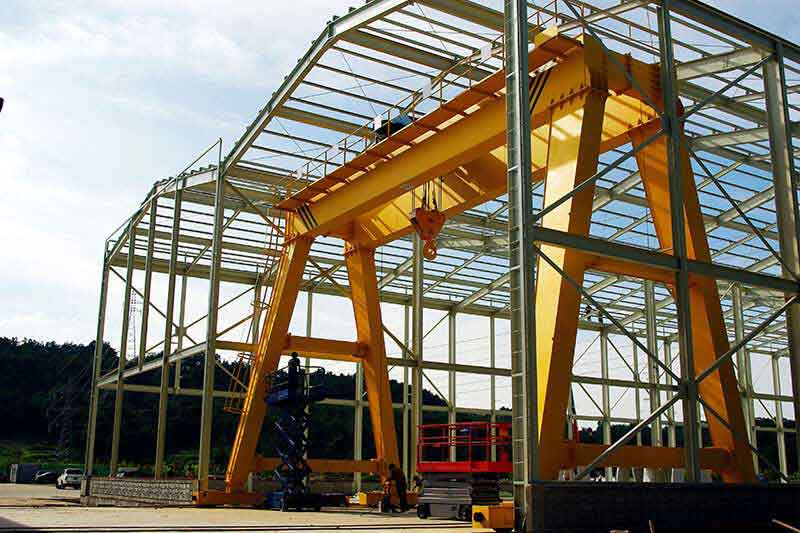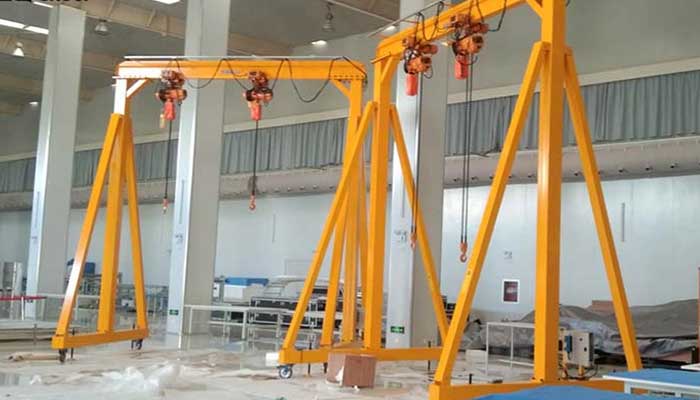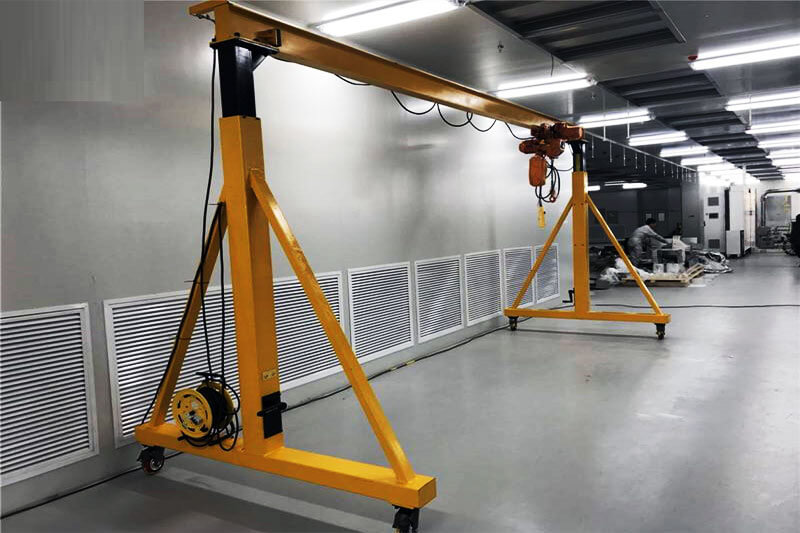10 Ton Electric Hoist Gantry Cranes in Electronics Manufacturing
10 Ton Electric Hoist Gantry Cranes in Electronics Manufacturing
10 Ton Electric Hoist Gantry Cranes for Sale. Custom gantry crane with electric hoist for handling Circuit boards, electronic components & precision machinery in electronics manufacturing plants & cleanroom environments.
A Comprehensive Buying Guide for Electric Hoist Gantry Cranes in Electronics Manufacturing
When it comes to the intricate world of Electronics Manufacturing, precision and efficiency are non-negotiable. In the heart of every manufacturing facility lies a crucial piece of equipment that plays a pivotal role in streamlining operations – the Electric Hoist Gantry Crane. As we delve into the complexities of this essential apparatus, this buying guide aims to illuminate the key considerations for anyone venturing into the purchase of an Electric Hoist Gantry Crane.
Electric Hoist Gantry Cranes, with their towering structures and cutting-edge lifting mechanisms, have become the backbone of material handling in manufacturing settings. These cranes are designed to lift and move heavy loads with utmost precision, making them indispensable in the world of Electronics Manufacturing where delicate components and intricate assemblies demand meticulous handling.
In the fast-paced realm of Electronics Manufacturing, where precision is paramount, the role of Electric Hoist Gantry Cranes cannot be overstated. These cranes facilitate the smooth and safe movement of sensitive equipment, ensuring that fragile components are handled with care from production to assembly. The ability to hoist loads with accuracy and efficiency significantly contributes to the overall quality and reliability of electronic products.
Material Handling Requirements of Electric Hoist Gantry Cranes
As we venture into the realm of Electric Hoist Gantry Cranes, the crucial second chapter of our buying guide embarks on the journey of understanding your specific requirements. Tailoring your choice to the unique demands of Electronics Manufacturing is paramount, and this section will guide you through the process.
Assessing Weight Capacity Needs
- Typical Loads in Electronics Manufacturing: In the intricate world of Electronics Manufacturing, loads can vary significantly. From small, delicate components to larger assemblies, the Electric Hoist Gantry Crane must be capable of lifting and transporting a diverse range of weights. Understanding the typical loads in your manufacturing processes is the first step in determining the necessary weight capacity of your crane.
- Future Scalability Considerations: Anticipating future growth and changes in your manufacturing processes is crucial. A forward-thinking approach to the capacity of your Electric Hoist Gantry Crane ensures that your investment remains relevant as your operations evolve. Consider not only your current needs but also the potential for increased load requirements in the future.
Determining Span and Height Requirements
- Space Constraints in Manufacturing Facilities: The physical layout of your manufacturing facility plays a pivotal role in selecting the appropriate span of the gantry crane. Assess the available space, taking into account the layout of workstations, machinery, and storage areas. The crane's span should be optimized to navigate through your facility without hindrance.
- Vertical Lifting Requirements: In Electronics Manufacturing, precision often extends vertically. Consider the height requirements for lifting loads to and from various workstations. The gantry crane's vertical lifting capabilities must align with the specific needs of your manufacturing processes, ensuring seamless integration into your workflow.
Power Supply Considerations
- Voltage and Phase Requirements: Understanding the electrical specifications of your facility is imperative. Electric Hoist Gantry Cranes operate on specific voltage and phase requirements. Ensure that the crane's electrical specifications align with those of your facility to prevent compatibility issues and guarantee optimal performance.
- Compatibility with Existing Electrical Systems: In many manufacturing facilities, the installation of new equipment must seamlessly integrate with existing systems. Assess the compatibility of the Electric Hoist Gantry Crane with your facility's electrical infrastructure to avoid unnecessary modifications and streamline the integration process.
Types of Electric Hoist Gantry Cranes
As we progress in our journey to demystify the world of Electric Hoist Gantry Cranes, the third installment of our buying guide explores the diverse types of gantry cranes available. Understanding the nuances of single girder versus double girder cranes, as well as fixed versus adjustable height configurations, is essential in making an informed decision tailored to the unique needs of Electronics Manufacturing.
Single Girder vs. Double Girder Cranes

Single Girder Electric Hoist Gantry Cranes
Advantages:
- Cost-Effective: Generally, single girder cranes are more economical, making them suitable for budget-conscious buyers.
- Lightweight: The single girder design results in a lighter structure, making these cranes easier to install and maneuver.
- Easier Maintenance: With fewer components, maintenance is often simpler and more cost-effective.
Disadvantages:
- Limited Capacity: Single girder cranes may have limitations in terms of lifting capacity compared to their double girder counterparts.
- Reduced Stability: They may exhibit less stability when lifting heavy loads at higher elevations.

Double Girder Electric Hoist Gantry Cranes:
Advantages:
- Higher Capacity: Double girder cranes excel in lifting heavier loads, making them ideal for demanding manufacturing environments.
- Increased Stability: The dual girder design enhances stability, especially during the lifting of substantial loads.
- Greater Hook Height: The configuration allows for increased hook height, catering to diverse lifting requirements.
Disadvantages:
- Higher Cost: Double girder cranes are typically more expensive upfront, which may be a consideration for budget-conscious buyers.
- Increased Weight: The additional girder results in a heavier structure, requiring more robust support systems.
Suitability for Electronics Manufacturing:The choice between single girder and double girder cranes depends on the specific demands of Electronics Manufacturing. If your operations involve primarily lighter loads and cost efficiency is a key consideration, a single girder crane may be suitable. However, for facilities dealing with heavier components and requiring increased stability, a double girder crane is often the preferred choice.
Fixed vs. Adjustable Height
The height configuration of your Electric Hoist Gantry Crane is integral to its adaptability within your manufacturing environment. Fixed height cranes are suitable for consistent lifting requirements, while adjustable height cranes offer flexibility to accommodate varying load sizes and workstations.
Space Optimization Considerations:
- Provide stability and simplicity in design.
- Ideal for consistent load sizes and manufacturing setups with standardized requirements.
- Allow for versatility in adapting to different workstation layouts.
- Optimal for facilities with varying load sizes and the need for precise vertical positioning.
These distinctions between single and double girder cranes, as well as fixed and adjustable height configurations, will guide you towards selecting the most fitting Electric Hoist Gantry Crane for your Electronics Manufacturing facility. In Part IV, we'll delve into the critical realm of safety features, exploring how these features contribute to the overall efficiency and well-being of your operations. Stay tuned for insights into overload protection, emergency stop systems, and more.
Safety Features
In the intricate dance of Electronics Manufacturing, precision and safety go hand in hand. Part IV of our Electric Hoist Gantry Crane buying guide delves into the essential safety features that can make or break your operations.
Overload Protection
- Importance in Preventing Accidents:In the delicate world of Electronics Manufacturing, where precision is key, the importance of overload protection cannot be overstated. Overloaded cranes pose a significant risk, not only to the safety of personnel but also to the integrity of valuable equipment. A robust overload protection system acts as a guardian, preventing accidents and preserving the delicate balance of your operations.
- Compliance with Safety Standards:Beyond preventing accidents, compliance with safety standards is a mandate in the manufacturing industry. Electric Hoist Gantry Cranes equipped with reliable overload protection mechanisms not only meet but exceed these standards, ensuring a secure environment for both operations and personnel.
Emergency Stop Systems
- Rapid Response to Potential Hazards:Rapid response capability is the hallmark of an effective Electric Hoist Gantry Crane. Emergency stop systems provide operators with the means to halt operations swiftly in the face of potential hazards, minimizing the risk of accidents and damage to sensitive equipment. In Electronics Manufacturing, where precision is paramount, this feature is a critical lifeline.
- Integration with Facility Safety Protocols:Safety is a holistic endeavor, and an effective Electric Hoist Gantry Crane seamlessly integrates with broader facility safety protocols. The ability of the crane's emergency stop systems to align with your facility's safety procedures ensures a cohesive and comprehensive approach to emergency response.
Limit Switches and Positioning Sensors
- Ensuring Precision and Accuracy:Precision is the heartbeat of Electronics Manufacturing. Limit switches and positioning sensors in Electric Hoist Gantry Cranes ensure that loads are positioned with accuracy, preventing overshooting or undershooting during lifting and movement. These features are the guardians of your operational precision.
- Enhancing Operational Safety:Beyond precision, these safety features contribute to overall operational safety by preventing the crane from exceeding specified limits. This reduces the risk of collisions, equipment damage, and potential injuries to personnel, ensuring a secure working environment.
In the next installment, Part V, we will venture into the structural core of Electric Hoist Gantry Cranes, examining the construction and material considerations that define their durability and reliability. Stay tuned for insights into the quality of steel components, the impact of surface treatments, and their implications for long-term use.
Special Requriements of Material Handling in Electromics Manufacturing
In the realm of Electronics Manufacturing, material handling is a mission-critical aspect that demands meticulous attention to detail. The delicate nature of electronic components, precision assembly processes, and the need for contamination-free environments impose special requirements on material handling systems. Here are some key considerations and special requirements specific to material handling in Electronics Manufacturing:
Anti-Static Measures
- Requirement: Electronics components are highly sensitive to electrostatic discharge (ESD), which can lead to malfunctions or damage.
- Special Measures: Material handling systems must incorporate anti-static measures, such as ESD-safe containers, flooring, and conveyors. Personnel should also use appropriate ESD protective gear.
Cleanroom Compatibility
- Requirement: Many electronics manufacturing processes occur in cleanroom environments to prevent contamination.
- Special Measures: Material handling equipment should be designed for cleanroom compatibility, with smooth surfaces, sealed joints, and minimal particle generation. Regular cleaning protocols and adherence to cleanroom standards are imperative.
Precision and Accuracy
- Requirement: Electronics components often have small dimensions, and precision during handling is crucial to avoid damage or misalignment.
- Special Measures: Material handling systems must offer precise positioning and accurate control. This includes the use of automation, robotics, and conveyors with high accuracy to ensure gentle and precise movement.
Customizable Configurations
- Requirement: Electronics manufacturing processes often involve diverse components with varying sizes and shapes.
- Special Measures: Material handling systems should be easily customizable to accommodate different sizes, shapes, and weights of electronic components. Adjustable fixtures and conveyors that can be tailored to specific requirements enhance flexibility.
Gentle Handling for Fragile Components
- Requirement: Fragile electronic components, such as microchips or sensors, require gentle handling to prevent damage.
- Special Measures: Material handling systems should incorporate features like soft grippers, vibration isolation, and shock absorption to ensure delicate components are handled with care.
Traceability and Data Integration
- Requirement: Traceability is crucial in electronics manufacturing for quality control and compliance.
- Special Measures: Material handling systems should integrate seamlessly with data management systems, incorporating RFID tags, barcodes, or other tracking technologies. This ensures the traceability of components throughout the manufacturing process.
High Throughput and Efficiency
- Requirement: The electronics industry often operates on tight production schedules, requiring high throughput and efficiency.
- Special Measures: Material handling systems should be designed for optimal speed and efficiency. Automated systems, conveyor belts, and robotic arms can contribute to faster and more efficient material movement.
Addressing these special requirements ensures that material handling systems in Electronics Manufacturing not only meet the industry's unique challenges but also contribute to the precision, efficiency, and reliability of the overall manufacturing process.
Special Electric Hoist Gantry Crane for Electromics Manufacturing
In the realm of Electronics Manufacturing, where precision and delicacy are paramount, the material handling equipment plays a pivotal role. An Electric Hoist Gantry Crane tailored to the unique requirements of this industry is essential for ensuring the safe and efficient movement of electronic components. Here are some special features and considerations for an Electric Hoist Gantry Crane designed specifically for Electronics Manufacturing:
ESD-Safe Design:
- Requirement: Electronics components are highly sensitive to electrostatic discharge (ESD).
- Special Measures: The crane should be designed with ESD-safe materials and features to prevent electrostatic buildup. Conductive wheels, ESD-safe coatings, and grounding options contribute to a static-free environment.
Cleanroom Compatibility:
- Requirement: Many electronics manufacturing facilities operate in cleanroom environments to prevent contamination.
- Special Measures: The crane should be designed with cleanroom-compatible materials, minimizing particle generation. Sealed components, smooth surfaces, and compatibility with cleanroom protocols are essential.
Lightweight Construction:
- Requirement: Delicate electronic components require gentle handling.
- Special Measures: The crane should be constructed with lightweight yet durable materials. Aluminum or other lightweight alloys can provide the necessary strength without adding excessive weight, ensuring careful handling of fragile components.
Precision Controls:
- Requirement: Electronics components often have small dimensions, requiring precise positioning.
- Special Measures: The crane should feature precision controls, allowing operators to maneuver with accuracy. Variable speed controls, adjustable frequency drives, and programmable options contribute to precise and controlled movements.
Adjustable Height and Span:
- Requirement: Electronics manufacturing processes may involve varied workstation configurations.
- Special Measures: An Electric Hoist Gantry Crane with adjustable height and span allows for flexibility in adapting to different workstation layouts. This feature ensures optimal use of space and efficient material handling.
Automation Integration:
- Requirement: The trend towards automation in Electronics Manufacturing demands integration capabilities.
- Special Measures: The crane should be compatible with automation systems, allowing for seamless integration into smart manufacturing setups. This includes connectivity options for data exchange and communication with other automated equipment.
Smart Safety Features:
- Requirement: Safety is paramount, especially in environments with delicate components.
- Special Measures: Incorporate advanced safety features such as collision avoidance systems, load monitoring, and real-time diagnostics. These features enhance operational safety and protect both personnel and valuable electronic equipment.
Adaptable Control Systems:
- Requirement: Electronics manufacturing workflows may require specific control interfaces.
- Special Measures: Provide adaptable control systems, such as pendant control and remote control options. This ensures operator convenience and allows for easy integration into Electronics Manufacturing workflows.
By incorporating these special features, an Electric Hoist Gantry Crane can be customized to meet the unique demands of Electronics Manufacturing. This specialized equipment contributes not only to the efficiency of material handling processes but also to the overall safety and integrity of delicate electronic components throughout the manufacturing journey.
Maintenance and Service
As we navigate the terrain of Electric Hoist Gantry Cranes in Electronics Manufacturing, the focus shifts to ensuring the longevity and reliability of your investment. Part VII of our buying guide explores the critical aspects of maintenance and service, integral to the seamless operation of your crane.
Ease of Maintenance
- Accessibility of Components:Ensuring the ease of maintenance begins with the accessibility of crucial components. Electric Hoist Gantry Cranes designed with user-friendly features, such as easily reachable parts and clear access points, simplify routine maintenance tasks. This accessibility not only saves time but also contributes to the overall efficiency of your operations.
- Maintenance Schedule and Requirements:Establishing a proactive maintenance schedule is key to preventing downtime and unexpected failures. Electric Hoist Gantry Cranes with clearly outlined maintenance requirements enable your team to stay ahead of potential issues, fostering a culture of preventative maintenance that pays dividends in the long run.
Availability of Spare Parts
- Supplier Support and Responsiveness:A reliable supplier is an indispensable partner in the lifespan of your Electric Hoist Gantry Crane. Assessing the support and responsiveness of your crane's supplier is crucial. A supplier committed to prompt communication, technical assistance, and readily available support enhances your ability to address maintenance issues swiftly.
- Minimizing Downtime in Case of Component Failure:Downtime can be a costly affair in manufacturing. Availability of spare parts plays a pivotal role in minimizing downtime in the event of component failure. Electric Hoist Gantry Cranes backed by suppliers with efficient spare parts logistics ensure that your operations can resume promptly, mitigating the impact on productivity.
As we transition into Part VIII of our buying guide, we'll explore the financial landscape of Electric Hoist Gantry Cranes. Cost considerations, return on investment, and the economic benefits of your investment will take center stage. Stay tuned for insights into the initial investment, long-term cost-effectiveness, and the potential for increased productivity in Electronics Manufacturing.
Cost Considerations
As we approach the financial facet of acquiring Electric Hoist Gantry Cranes for Electronics Manufacturing, Part VIII of our comprehensive buying guide dives into the critical considerations of cost. Balancing the initial investment with long-term cost-effectiveness is essential for making a financially sound decision.
Initial Investment
- Cost vs. Features Analysis:Conducting a thorough cost vs. features analysis is the cornerstone of your decision-making process. Evaluate the features offered by different Electric Hoist Gantry Cranes in relation to their respective costs. Striking the right balance ensures that you acquire a crane equipped with the necessary functionalities without unnecessary expenses.
- Long-term Cost-effectiveness:While the initial investment is a crucial factor, long-term cost-effectiveness should not be overlooked. Consider the maintenance requirements, energy efficiency, and the durability of the crane. An investment in a high-quality crane may entail a higher upfront cost but can prove more economical over its operational lifespan.
Return on Investment (ROI)
- Evaluating the Economic Benefits Over Time:Assessing the return on investment involves looking beyond the immediate costs. Consider the economic benefits that the Electric Hoist Gantry Crane brings to your Electronics Manufacturing operations. Increased efficiency, reduced downtime, and improved safety all contribute to the overall ROI.
- Potential for Increased Productivity:The true measure of ROI lies in the crane's potential to enhance productivity. A crane that streamlines material handling processes, minimizes delays, and contributes to a more efficient workflow can lead to increased production output. Evaluate the crane's impact on your facility's productivity over time to gauge its true economic value.
Customer Support and Warranty
As we approach the conclusion of our buying guide, the importance of robust customer support and warranty terms cannot be overstated. Ensuring that your investment is backed by a reliable manufacturer is key to the long-term success of your operations.
Manufacturer Reputation
- Researching Customer Feedback and Reviews:Dive into customer feedback and reviews to gauge the reputation of the Electric Hoist Gantry Crane's manufacturer. Real-world experiences from other users provide valuable insights into the reliability, performance, and customer satisfaction associated with a particular brand.
- Longevity and Reliability of the Manufacturer:A manufacturer's longevity and track record in the industry speak volumes about their reliability. Choose a manufacturer with a proven history of producing durable and dependable Electric Hoist Gantry Cranes.
Warranty Terms and Conditions
- Understanding Coverage and Duration:Scrutinize the warranty terms and conditions offered by the manufacturer. Understand the coverage provided and the duration of the warranty. A comprehensive warranty reflects the manufacturer's confidence in the quality and durability of their product.
- Support Availability and Responsiveness:Evaluate the availability and responsiveness of customer support. In the event of issues or questions, a manufacturer with responsive and accessible support can expedite resolutions, minimizing disruptions to your operations.
As we approach the conclusion of our buying guide journey, the last installment will summarize the key considerations and offer final thoughts on selecting the optimal Electric Hoist Gantry Crane for Electronics Manufacturing. Stay tuned for the conclusion, where we bring together the insights gathered throughout this guide.
Conclusion
As we draw the curtain on our journey through the intricacies of Electric Hoist Gantry Cranes in Electronics Manufacturing, it's time to distill the wealth of information into actionable insights. In this concluding segment, we recap the key considerations, encourage informed decision-making, and underscore the critical importance of selecting the right crane for your manufacturing needs.
Throughout this buying guide, we've delved into critical aspects to consider when investing in an Electric Hoist Gantry Crane. From understanding your specific requirements, exploring safety features, and assessing construction materials, to evaluating cost considerations, return on investment, and the reliability of customer support – each consideration contributes to the holistic decision-making process.
- Requirements Understanding: Assessing weight capacity, span, height, and power supply needs.
- Types of Cranes: Choosing between single and double girder cranes, fixed or adjustable height configurations.
- Safety Features: Overload protection, emergency stop systems, limit switches, and positioning sensors.
- Maintenance and Service: Ease of maintenance, availability of spare parts, and supplier responsiveness.
- Cost Considerations: Initial investment, cost vs. features analysis, and long-term cost-effectiveness.
- Return on Investment: Evaluating economic benefits and potential for increased productivity.
- Customer Support and Warranty: Researching manufacturer reputation and understanding warranty terms.
Informed decision-making is the linchpin of a successful investment. We encourage you to meticulously weigh each consideration against your specific needs. Tailoring your choice to the unique demands of Electronics Manufacturing ensures that your Electric Hoist Gantry Crane becomes an asset rather than a mere piece of equipment.
Engage with suppliers, seek expert advice, and leverage the wealth of information available to make decisions aligned with your operational goals. The time invested in thorough research and consideration will pay dividends in the form of enhanced efficiency, reduced downtime, and a safer working environment.
In the intricate dance of Electronics Manufacturing, where precision and efficiency reign supreme, the selection of the right Electric Hoist Gantry Crane is not just a choice but a strategic investment. The crane becomes an integral part of your workflow, influencing productivity, safety, and the overall success of your operations.
Choosing a crane that aligns with your specific needs and industry standards is a commitment to the seamless flow of your manufacturing processes. It's an investment in the safety of your personnel, the longevity of your equipment, and the economic prosperity of your operations.





